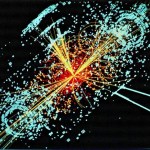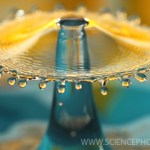Physics
One of the things I forgot to mention in yesterday's post about why I like AMO physics is that AMO systems have proven to be outstanding tools for solving problems from other fields of physics. In particular, ultra-cold atoms have proven to be a fantastic venue for studying problems from condensed matter physics. There's a comprehensive review of the subject in this Reviews of Modern Physics paper, which is also freely available on the arxiv. I say "comprehensive review," but, of course, it's almost certainly already out of date, given how much work is going on in this area.
To understand why…
A purely hypothetical situation for today's poll. Purely.
You have agreed to read and review six grant proposals by Sunday. Today is Thursday, and you have not read them yet. What do you do?(poll)
If anybody needs me, I'll be in an undisclosed location not responding to email.
Have I not made it clear how much I like the MythBusters? Also, I am totally aware that they are not (nor do they claim to be) scientists. Really, this is what makes their show appealing (maybe?). So here is the problem now. And, it is not just the MythBusters - I see other shows making the same mistake.
If two things are colliding, how do you characterize the collision? No one really gets this right. For this particular episode, the MythBusters were looking at the collision between a bullet and gun. They wanted to see how hard it would be to shoot a gun out of someone's hand. The…
Months ago, during the DonorsChoose fundraiser, I offered to answer questions from people who donated to the Challenge. I then promptly forgot to respond to the questions sent in. Mea maxima culpa. Here's a way-too-late response to a good question from "tcmJOE":
I've spent the past few years trying to explore physics and figure out what I would be interested in doing--I've settled more towards energy research, somewhere between CM and MatSci, but I've tried at a variety of different things in the along the way. So my question for you is: How did you end up in AMO? Were there any other fields…
This is a requested post. Clearly, I do requests. The idea here is that I am going to give all the details needed to determine the equation of motion (and then model it) for a basic pendulum. Warning: this post is a little more advanced than my normal posts. There are some prerequisites. You need to understand derivatives. I will assume that you do. Here is a pendulum. (and this time I will stick to my variables)
Like I said before, this is a tricky problem unless I use some tricks. The problem is that the tension the string exerts on the mass changes. Here is my trick: think about a…
John Scalzi sends along photographic proof of How to Teach Physics to Your Dog working for a dog who isn't Emmy:
This isn't quite an "in the wild" shot, as it's not at a store or a store-bought copy (John wrote a blurb for the book, so he got sent a copy), but we're getting close. The official release date is just two weeks from today. It may well start showing up in stores before then (it's not in the Barnes & Noble store in Colonie yet, though I swear I did not go in there just to check that...). You can, of course, order it from Amazon, as several people have obviously done already,…
You don't understand. You can't just come to the Sea of Galilee and start walking on water. If you could, everybody would be doing it. You need to prepare yourself. -Walk on Water
As some of you may have noticed from looking at the site over the past few days, Scienceblogs has partnered with National Geographic. To celebrate this, I want to show you one of my favorite National Geographic clips of all time, showcasing the Central American Basilisk. (Its nickname? "The Jesus Lizard.") Why? You'll see...
This lizard weighs little enough, has feet with a big enough surface area, and can move…
Looking back at part I of this idea, I don't think I did a very good job. Let me summarize the key things I wanted to say:
Normally, there are two ways of modeling the motion of an object:
Calculating the forces on the object and using the momentum principle or Newton's second law (which are the same thing). I called this the Newtonian way. The problem with this method is forces that constrain the motion (like the normal force). These forces have a variable magnitude to make the object stay on a particular surface.
Defining some variables that describe the system as it is constrained.…
You're making me angry. You wouldn't like me when I'm angry. -Bruce Banner
Hey, LHC, what did those protons ever do to you? You take them, accelerate them to the fastest speeds we've ever accelerated protons to on Earth, and then smash them into one another with more energy than ever before!
The Large Hadron Collider takes bunches of protons, accelerates them in opposite directions inside its giant ring, and smashes them together -- ideally -- at the centers of these giant detectors.
At Fermilab, each proton would come in with an energy up to about 1.0 TeV, for a total collision energy of 2…
I've made a couple of oblique references to this over the past couple of months, but I have an article in the new issue of Physics World, on experiments using molecules to search for an electric dipole moment of the electron:
When most of us think about searching for physics beyond the Standard Model - the dominant paradigm of particle physics - the first thing that springs to mind is probably a gigantic particle accelerator like CERN's Large Hadron Collider (LHC). Within the collider's 27-km loop, protons slam together at 99.9999991% of the speed of light. Office-building-sized detectors…
One of the roads near my house was just redone. They added some awesome retroreflectors in the middle. Here is a shot. No wait, I don't have a picture of that. I tried to take one, but it just didn't turn out very well. Oh, you know what it is supposed to look like. It looks like little tiny lights in the middle of the road.
What makes these things so cool? Why do they look like they are battery powered or something? Maybe it would be helpful to compare retroreflectors to some other materials. I can group stuff in the following manner:
Shiny stuff
Non-shiny stuff
Retroreflectors…
Back during the DonorsChoose fundraiser, I promised to do a re-enactment of the Bohr-Einstein debates using puppets if you contributed enough to claim $2,000 of the Hewlett-Packard contribution to the Social Media Challenge. I obviously aimed too low, because the final take was $4064.70, more than twice the threshold for a puppet show.
So, I put together a puppet show. It took a little while, because I couldn't find any Niels Bohr puppets (maybe in Denmark?). I found an acceptable alternative, though, and put together a video of the Bohr-Einstein debates, using puppets. Here's the whole thing…
Rhett Allain's Dot Physics has joined ScienceBlogs. Sweet.
Update your RSS readers accordingly. That is all.
I am moving to ScienceBlogs.com. So, as I have said before, basically it will be the same stuff, new server. As of right now, only my new stuff is at http://ScienceBlogs.com/dotphysics, but soon all my old stuff will be there too.
To summarize:
It is not you, it's me.
Thousand points of light.
Change your bookmarks (do people even still use those?)
Change your RSS reader.
Update
Here is the RSS feed at the new sitehttp://scienceblogs.com/dotphysics/index.xml
Fluids are a constant source of inspiration for high speed photography. Water and milk are two of the common liquids around us every day, but still their complex behavior is a source of wonder. Fluid scientists are still pioneering some of the basic equations that are responsible for the complex motion of fluids. In these pictures a drop of liquid is falling into a container of liquid. The first falling drop creates a recoil splash that shoots up out of the container. Just when the recoil droplet gets to the top of its motion a second falling droplet collides. The timing often happens…
The official release date for How to Teach Physics to Your Dog is three weeks from tomorrow, but a couple of new reviews have been posted, one linkable, the other not so much. The linkable one is from one of our contest winners, Eric Goebelbecker, at Dog Spelled Forward (an excellent name for a dog-related blog):
Quantum physics can be some heavy stuff, and this book teaches you the basics without dumbing it down or putting you to sleep. Professor Orzel has a gift for funny dialogue and straightforward explanation. In addition to the entertaining conversations with Emmy, there are fascinating…
A few other people got the same email I did, promoting a list of the 50 Best Physics Blogs put together by Accredited Online Colleges Dot Org. It's a fine list, with one glaring problem: They didn't include Matt Springer's Built On Facts. As you can probably tell from its frequent tagging for the daily links dump, I'm a big fan, and think Matt's got one of the best physics blogs going.
I could probably come up with a blog or two that I'd drop off the existing list, but that would be impolitic. So let's just add him as the 51st blog, leaving us one blog shy of a pack of cards. The comments of…
This year's episode of Punkin Chunkin is coming up (I think tomorrow). Discovery just showed a teaser commercial with the specifications for one team's machine. If you are not familiar with Punkin Chunkin (World Championship Punkin Chunkin), the basic idea is to project some pumpkins. (note, if you waiting for the Discovery Channel show for the 2009 Punkin Chunkin, don't click on the previous link, it has the results already).
One of the categories for Punkin Chunkin is the centrifugal machine. These are machines that spin pumpkins around really fast in circles to shoot them. They are…
Thony C has a post about the Great Man theory of science spinning off some thoughts about Darwin by ex-ScienceBlogs silverback John Wilkins. As Thony writes:
Now you may ask why I as a historian of Renaissance mathematics should comment on a blog post about a 19th century work of biology and its author? The answer is quite simple; everything that John says about Darwin and his book can and should be applied to Copernicus, Kepler, Galileo, Descartes, Newton and a host of other scientist from the early modern period and their works.
Nothing that any of these scholars did or wrote existed in a…
Some notes for quantum computing people:
IARPA will be hosting a Proposers' Day Conference for the Quantum Computer Science (QCS) Program on December 17, 2009 in anticipation of the release of a new solicitation in support of the program. Details here
Submissions for TQC 2010 in Leeds are now open at http://tqc2010.leeds.ac.uk.
Digging through my inbox I noticed that I forgot to advertise the following quantum postdoc:
The physics of quantum information group at the department of physics of the Universite de Sherbrooke invites applications for up to three postdoctoral positions. The group…



